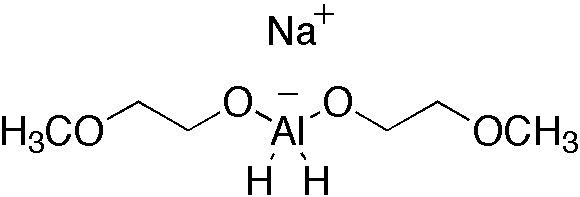Abbreviations SMEAH Appearance Transparent crystals | Density 1,036 g/cm³ | |
 | ||
Sodium bis(2-methoxyethoxy)aluminumhydride (trade names Red-Al, Synhydrid, Vitride) is an organoaluminium compound with the formula NaAlH2(OCH2CH2OCH3)2. The trade name Red-Al refers to its being a reducing aluminium compound. It is used predominantly as a reducing agent in organic synthesis. The compound features a tetrahedral aluminium center attached to two hydride and two alkoxide groups, the latter derived from 2-methoxyethanol. Commercial solutions are colourless/pale yellow and viscous. At low temperatures, the solution solidifies to a glassy pulverizable substance. No sharp melting point was found.
Sodium bis(2-methoxyethoxy)aluminumhydride is a versatile hydride reducing agent. It readily converts aldehydes, ketones, carboxylic acids, esters, acyl halides, and anhydrides to primary alcohols. The cyclic compounds such a lactones and epoxides are reduced to diols. Nitrogen derivates such a amides, nitriles, imines, and most other organonitrogen compounds are reduced to the corresponding amines. Nitroarenes can be converted to azoxyarenes, azoarenes, or hydroazoarenes, depending on the reaction conditions.
Some common functional group reductions using sodium bis(2-methoxyethoxy)aluminumhydride can be found below:
Comparison with lithium aluminium hydride
As a reagent, sodium bis(2-methoxyethoxy)aluminumhydride is comparable with lithium aluminum hydride (LAH, LiAlH4).
It is a safer substitute for LAH and related hydrides. Sodium bis(2-methoxyethoxy)aluminumhydride exhibits similar reducing effects, but does not have the inconvenient pyrophoric nature, short shelf-life, or limited solubility of LAH. Upon contact with air and moisture, Sodium bis(2-methoxyethoxy)aluminumhydride reacts exothermically but does not ignite, and tolerates temperatures up to 200 °C. Under dry conditions it has unlimited shelf life. It is soluble in aromatic solvents, whereas LAH is only soluble in ethers. For example, a solution greater than 60 wt.% concentration in toluene is commercially available. The reagent can be modified to effect partial reductions.
Red-Al in toluene under reflux has been used to reduce aliphatic p-toluenesulfonamides (TsNR2) to the corresponding free amines and is one of the few reagents that can carry out this challenging reduction in general settings. Notably, LiAlH4 does not reduce this functional group unless forcing conditions are used.
